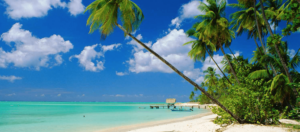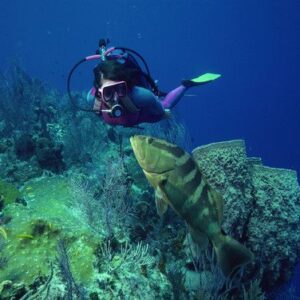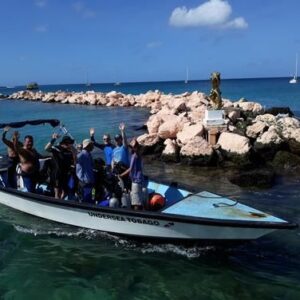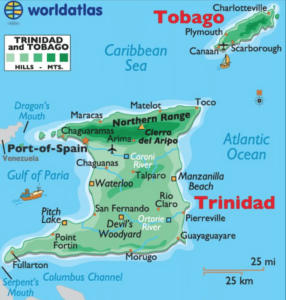Laidback Destination/Excellent Drift Dives
Located just north of Venezuela, Trinidad and Tobago is a dual-island Caribbean nation known for Creole traditions, cuisines, and underwater adventures. Trinidad is the larger island and is the country’s industrial center while the small sister island of Tobago is known for tourism and is a popular tourist destination. Known as the drift diving capital of the Caribbean, the islands offer many experiences for the discerning scuba diver. With dive sites for every experience level, diving here is a unique experience compared to many of the other Caribbean diving locations.
The location of the islands just north of Venezuela and at the mouth of the Orinoco River means that dives are fueled by the Guyana Current. The current bathes the eastern coast of the island in nutrient-rich waters that support the growth of corals and attracts an abundance of life to the area. With over 50 established dive sites, divers can expect huge, healthy coral reefs, a spectacular array of marine life, varied underwater topography, sunken ships, and submarine cliffs.
GETTING THERE
Air: International flights arrive at Tobago’s A.N.R Robinson International Airport. Trinidad’s Piarco International Airport services daily 25-minute flights between the two islands.
GETTING AROUND
Car Rental: If planning to leave the city, a car rental is most appropriate. Car rentals are available in the cities and at the airports.
Taxis: Taxis are ideal for short distances or off-route trips. Visitors can download Allridi, PinkCab or TTRS, the island’s equivalent of Uber.
Public Transportation: Public transportation is a budget-friendly way to get around the island. Maxi-taxis are government approved color coded passenger vans with the letter “H” on the license plate and operate on a fixed route.
Local Ferries: Local ferries offer trips twice a day at the jetty in Independence Square, Port of Spain and three times a day from the cruise ship complex in Scarborough
GOOD TO KNOW
Country: Independent Nation in the Southeastern West Indies
Time Zone: UTC-4:00 in the winter and UTC-5:00 in the summer
Primary Language: English
Currency: Trinidad and Tobago dollar. (TTD) US dollars are widely accepted.
Cell Phone Service: Check with the local service provider for data plans available or roaming fees will apply.
Voltage: 115V Plug A and B
Passport and Visa: A valid passport is required for all US citizens. The passport must be valid for at least 6 months beyond the date of entry and must have at least one blank page. Those leaving Trinidad and Tobago on an international flight must pay a departure tax of 100 TTD.
Hurricane Details: Trinidad and Tobago lie just below the hurricane belt. Hurricane season is from June-November
DIVE CONDITIONS
Water Temperature: 78-84 degrees F
Water Visibility: 16-98 Feet
When to Go: Trinidad and Tobago are year-round diving destinations, but visibility is lower during the rainy season from July-December.
Diving Difficulty: Beginner-Advanced
TOP DIVE SITES IN TRINIDAD AND TOBAGO
Trinidad and Tobago caters to the diving enthusiast! Listed are some of the very best that these islands can offer divers:
- MV Maverick is a 350-foot-long car and passenger ferry suited for advanced divers. The ferry was intentionally sunk off Rocky Point in 1997 to create an exciting dive spot and is considered one of the most famous dives found in the Caribbean. The ferry sits upright and is perfectly intact. Now transformed into a thriving ecosystem teeming with marine life, divers can easily penetrate the ferry and access the engine rooms. The wreck boasts rich growths of coral and schools of fish, barracuda, crabs, lobsters, and moray eels.
- Keleston Drain is home to the Caribbean’s largest brain coral at over 15 feet in diameter. Sometimes known as Keleston Deep or Little Tobago, this dive site is home to moray eels, big schools of Creole wrasse, manta rays, barracuda, and reef sharks. This is a fascinating drift dive featuring colorful sponges, swaying sea fans, sea whips, sea rods, branching corals, gorgonians, and small feather black coral.
- The Sisters is a five-pinnacle rock formation located 1.5 miles from the coast in English Bay. The area attracts hammerhead sharks, nurse sharks, stingrays, and whales. The pinnacles act like a slope providing the perfect home for soft coral. At a depth of 140 feet, the large boulders on the sea floor provide shelter for turtles, lobsters, moray eels and an abundance of tropical fish.
- Flying Reef is a shallow reef 50 feet deep on the Atlantic side of Tobago. The name of this site comes from the swift water currents. Divers can drift past enormous colonies of plate coral. The area hosts soft corals and enormous sponges. A variety of different reef fish swim around the reef and stingrays bury themselves in the sandy bottom to help make this dive full of color and action. A large ship anchor can be found along the reef surrounded by pork fish, turtles, schools of big eye snapper and French angel fish. This dive is a perfect introduction to drift diving.
- Mount Irvine Wall and Extension are a perfect introduction to marine diversity. The area is home to the Mount Irvine Wall which is a shallow wall encrusted with numerous corals. The crevices and ledges house a plethora of life including moray eels, crabs, seahorses, reef fish, and fire clams. The canyons and ledges are home to schooling fish. The Extension is a deeper area of the dive the follows outcropping rocks to a large coral reef. The coral reef is home to tarpon, spotted eagle rays and turtles.
- Kariwak Reef located close to Store Bay Beach is perfect for beginner divers. The dive is flat with little to no current and begins on a sandy bottom. The stunning reef is home to angel fish, southern stingrays, squids, scorpion fish and trumpet fish. This site is wonderful for night diving as well.
- Speyside is an area on the northeastern coast of the island in the Atlantic Ocean. The area is home to twenty diving sites, impressive corals, and outstanding visibility. Some of the island’s best drift dives are done in Speyside. The current here propels divers along the sloping reef. Speyside gives divers the best chances of spotting hawksbill turtles, nurse sharks, pine turtles and manta rays.
- Bookends is located to the south of Speyside and is known for turbulent currents. Suited for the more advanced diver, encounters with giant tarpons, nurse sharks, blacktip sharks and shoal fish are common. This site is named for the two enormous rock slabs that rise above the water.
- Japanese Garden is a breathtaking site that is suitable for all levels of divers. Located on the edge of Goat Island, divers descend along a steep slope covered in colorful tubes, rope, and vase sponges until reaching the Kamikaze tunnel. From inside the tunnel, divers will enjoy the underwater scene of sea whip corals that look like bonsai plants. The area resembles a serene Japanese garden. Divers can spot large schools of mackerel, jacks, and nurse sharks.
- Diver’s Thirst caters to advanced divers and requires the perfect conditions to enjoy it. Here divers can enjoy large schools of fish, nurse sharks, eagle rays and the majestic manta ray. This is the best spot to see larger sharks.
- Diver’s Dream is suited for advanced divers. The site has strong currents and less than favorable conditions. Carved by the currents, unusual shaped gorgonian corals and barrel sponges are home to reefs, tiger, and bull sharks.
- Castara is perfect for beginner divers and a popular spot located on the Leeward coast. This is an easier, shallow dive with rock formations.
- Englishman’s Bay can be reached from the beach or boat. The beach is considered one of the most beautiful beaches on the island. The current is gentle, and the reef is full of fish. This is also a perfect place for snorkeling or relaxing between dives.
- Cove is located south of Crown Point and is for advanced divers. With stronger currents and a steep gradient, the Cove is home to a variety of beautiful corals, sea fans and sea rods. Divers can spot parrot fish, lobsters, creole fish, moray eels, stingrays, and turtles.
TOP ATTRACTIONS IN TRINIDAD AND TOBAGO
- Port of Spain is home to most of the historical buildings on the island. One of the more significant 19th century buildings is the All-Saints’ Anglican Church which is one of the oldest churches on the island. The Magnificent Seven is a group of mansions that were built in the 1900’s. The buildings include the Queen’s Royal College, Hayes Court, Millie Fleurs, Ambard’s House, Archbishop’s Palace, Whitehall, and Stollmeyer’s Castle. National Academy for Performing Arts is a 1500 seat theatre that opened in 2009. Temple of the Sea is a Hindu temple built by Siewdass Sadhu. The base of the building was built stone by stone being hand carried in a leather bag to the offshore location.
- Betsey’s Hope is a fort built to protect the sugar crop on the estate located in Roxborough. The battery overlooks Queen’s Bay and was named for the plantation owner’s wife, Betsey.
- Cambelton Battery was built in 1777 to protect the island from American privateers. The battery offers panoramic views of Charlotteville on one side and Pirate’s Bay on the other.
- Fort Bennet was a military fort built in Black Rock in 1628 to protect sugar loading operations from American Privateers.
- Fort George overlooks the city of St James and built in 1804. This is a well-preserved structure where visitors can see cannons and dungeons.
- Fort Granby is the island’s second oldest fort built in 1765 to protect Georgetown, the first capital of Tobago. Although there are few remains of the structure, visitors will enjoy the labyrinth of trees.
- Fort James was established in 1760 and overlooks Great Courland Bay. Visitors can enjoy visiting the town of Plymouth where the fort is located.
- Fort King George is the most well-preserved colonial fort in Tobago. This historical fort was built in the 1770’s in honor of King George. Visitors can view the fort as well as the Tobago Museum.
- Waterfalls are abundant on the islands. Some of them worth a visit are Angel Falls, Angyle Waterfall, Avocat Waterfall, Covigne River Gorge, Edith Falls, Habio Falls, Highland Waterfall, Paria Waterfall, Rio Seco Waterfall, and Turure Waterfall.
- Gasparee Caves are caves created by years of acid rain on the island of Gaspar Grande. Blue Grotto is a 100 feet underground cave that hosts a clear tidal pool. Located on Gasparee Island, Trinidad which is a 25-minute boat ride from the Port of Spain.
- Mount Tamana Bat Caves offers visitors the opportunity to view thousands of bats including vampire bats, fruit bats and insect bats as they leave the cave in search of food.
- Adventure Farm and Nature Reserve is a small plantation that grows citrus fruit. Bird watchers flock to this 12-acre estate to see species of birds such as Blue Tangers and Mot Mot birds.
- Nylon Pool is a shallow pool surrounded by the sea. It is said that the clear waters can rejuvenate those who swim there.
- Grand Riviere Beach is a nesting ground for the leatherback turtle. Over 500 leatherback turtles come ashore to lay eggs from March to August during nesting season.
- Trinidad Carnival is a street party and parade that takes place in February. The carnival is held on both islands and celebrates life.
The islands of Trinidad and Tobago offer visitors white-sand beaches, lush rainforests, lively nightlife, and phenomenal diving. Sitting in the middle of the Guyana Current, the flow of nutrients attracts an abundance of marine life unique to the islands. Divers can expect some of the best diving in the Caribbean and land lovers will enjoy the culture and history. Tobago and Trinidad offer a magical underwater world and a stunning top side vacation that ensures enjoyment from all that visit this Caribbean paradise.











